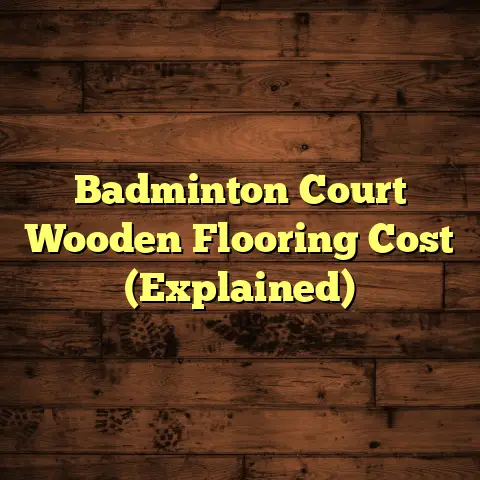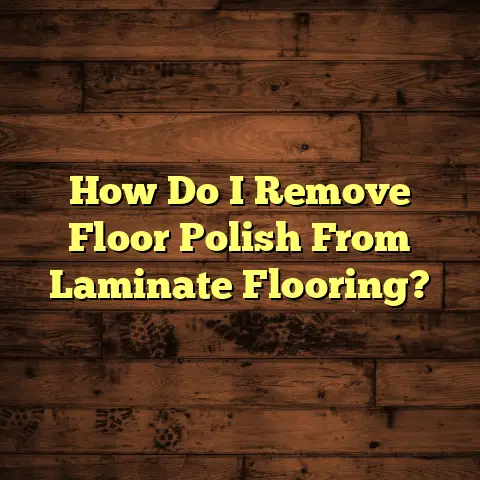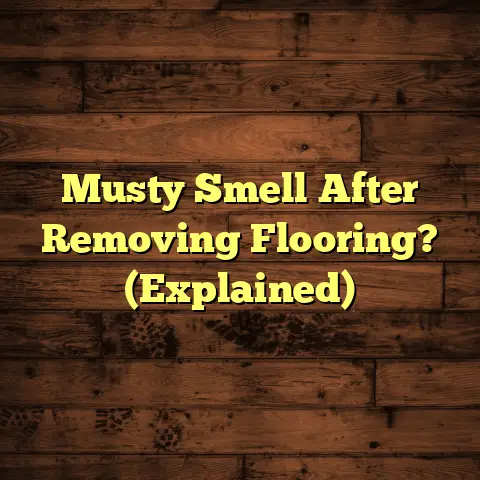What to Wash Tile Floors With? (1 Secret Cleaner!)
Hey fellow home improvement enthusiasts!
I get it. There’s something deeply satisfying about transforming a space, isn’t there?
Whether it’s a weekend DIY project, a fresh coat of paint, or meticulously chosen decor, we pour our hearts into creating homes we love.
And let’s be honest, for many of us, that love extends to the details – especially the floors!
Clean floors not only make your house sparkle, but they also contribute to a healthier, happier living space.
Tile flooring, with its durability and endless design possibilities, is a popular choice.
But keeping those tiles pristine? That’s where things can get a little tricky.
You’re probably asking yourself, “What should I wash my tile floors with?”
Well, I’m here to let you in on a little secret.
I’m going to reveal one particularly effective cleaner that might just become your new go-to.
Stick around, because I’m about to share some insider knowledge that’ll have your tile floors looking their absolute best!
Section 1: Understanding Tile Floors
Before we dive into the world of cleaners, let’s talk tile.
Not all tiles are created equal, and understanding the differences is crucial for effective cleaning.
Types of Tile Flooring
-
Ceramic Tile: This is your workhorse. It’s made from clay, fired at high temperatures, and often glazed for a protective finish.
Ceramic is budget-friendly, water-resistant, and comes in countless styles.
-
Porcelain Tile: Think of porcelain as ceramic’s tougher cousin.
It’s also made from clay, but fired at even higher temperatures, making it denser, less porous, and more durable.
Porcelain is ideal for high-traffic areas and places prone to moisture.
-
Natural Stone Tile: This is where things get fancy. We’re talking granite, marble, slate, travertine – each with its unique character and beauty.
Natural stone is incredibly durable but also more porous than ceramic or porcelain, requiring special care and sealing.
Did you know? According to the National Tile Contractors Association (NTCA), proper installation and maintenance are key to maximizing the lifespan of natural stone tile.
Common Issues Faced with Tile Floors
No matter what type of tile you have, you’re bound to encounter some common issues:
-
Dirt Accumulation: This is the daily grind. Foot traffic, pets, and everyday life bring in dirt and grime that settle on your tile surface.
-
Stains: Spills happen. Whether it’s coffee, wine, or pet accidents, stains can be a real headache, especially on lighter-colored tiles or porous stone.
-
Grout Discoloration: Ah, grout. The bane of every tile owner’s existence. It’s porous and easily absorbs dirt, grime, and spills, leading to unsightly discoloration.
-
Hard Water Spots: If you have hard water, you’re likely familiar with those stubborn white spots that appear after cleaning.
The Importance of Choosing the Right Cleaning Products
Now, here’s the golden rule:
The wrong cleaner can wreak havoc on your tile floors.
I’ve seen it happen too many times.
Using harsh chemicals on natural stone can etch the surface, dulling its shine.
Abrasive cleaners can scratch glazed ceramic or porcelain.
Even seemingly mild cleaners can leave a residue that attracts more dirt over time.
That’s why it’s crucial to choose cleaning solutions specifically formulated for your tile type.
Read the labels carefully and always test a small, inconspicuous area first to ensure compatibility.
Section 2: Conventional Tile Floor Cleaners
Okay, let’s explore the world of tile floor cleaners.
You’ve got options, from commercial solutions to DIY concoctions.
Overview of Conventional Cleaners
The cleaning aisle can be overwhelming.
Here’s a rundown of some common commercial tile floor cleaners:
-
All-Purpose Cleaners: These are generally safe for ceramic and porcelain, but avoid using them on natural stone as they can be too harsh.
Look for pH-neutral formulas.
-
Tile and Grout Cleaners: These are specifically designed for tile floors and often contain ingredients to tackle grout discoloration.
Be sure to choose one appropriate for your tile type.
-
Stone Cleaners: These are formulated for natural stone, with gentle ingredients that won’t damage the surface.
Avoid anything acidic, like vinegar or lemon juice.
-
Steam Mops: These use hot steam to loosen dirt and grime, making them a great chemical-free option for ceramic and porcelain.
Note: Steam mops are generally not recommended for natural stone, as the heat can damage the sealant.
Homemade Cleaning Solutions
For the DIYers out there, homemade cleaners can be a great option.
They’re often more affordable, eco-friendly, and allow you to control the ingredients.
Here are a few popular recipes:
-
Vinegar and Water: Mix equal parts white vinegar and water in a spray bottle.
This is a good option for ceramic and porcelain, but avoid using it on natural stone or grout, as the acidity can damage them.
-
Baking Soda Paste: Mix baking soda with enough water to form a paste.
Apply to stubborn stains or grout, let it sit for a few minutes, then scrub and rinse.
-
Dish Soap and Water: A mild solution of dish soap and warm water can be effective for general cleaning of ceramic and porcelain.
Be sure to rinse thoroughly to remove any residue.
-
Essential Oils: Adding a few drops of essential oils like tea tree, lavender, or lemon to your cleaning solution can provide antimicrobial benefits and a pleasant scent.
Just be sure to dilute them properly.
Pros and Cons of Each Cleaner
Let’s weigh the advantages and disadvantages:
| Cleaner Type | Pros | Cons |
|---|---|---|
| Commercial Cleaners | Convenient, readily available, formulated for specific tile types | Can be expensive, may contain harsh chemicals, environmental impact |
| Homemade Cleaners | Affordable, eco-friendly, customizable | May not be as effective for tough stains, requires preparation |
According to a study by the Environmental Working Group (EWG), many commercial cleaning products contain ingredients that can be harmful to human health and the environment.
Section 3: The Secret Cleaner Revealed
Alright, drumroll please!
It’s time to unveil my secret weapon for sparkling tile floors.
I call it “The Grout Buster Blend.”
It’s a simple yet incredibly effective cleaner that combines the power of natural ingredients to tackle dirt, grime, and even stubborn grout discoloration.
Ingredients and Preparation
Here’s what you’ll need:
- 1/2 cup of hydrogen peroxide (the 3% solution you find at the drugstore)
- 1/4 cup of baking soda
- 1 teaspoon of liquid dish soap (I prefer a natural, unscented variety)
- Warm water
- Spray bottle
- Old toothbrush or grout brush
Instructions:
-
In a bowl, combine the hydrogen peroxide and baking soda.
It will fizz a bit, which is normal.
-
Add the dish soap and stir gently to combine.
-
Pour the mixture into a spray bottle and fill the rest of the bottle with warm water.
-
Shake gently to mix.
Effectiveness and Benefits
So, why is this cleaner so effective?
-
Hydrogen Peroxide: This acts as a natural bleach and disinfectant, helping to lift stains and kill bacteria.
-
Baking Soda: This is a mild abrasive that helps to scrub away dirt and grime without scratching the tile surface.
-
Dish Soap: This helps to cut through grease and grime, leaving your floors sparkling clean.
The Grout Buster Blend is:
- Eco-Friendly: Made with natural ingredients that are safe for your family and the environment.
- Affordable: Costs just pennies per batch compared to commercial cleaners.
- Versatile: Can be used on ceramic, porcelain, and even some natural stone (always test in an inconspicuous area first).
- Effective: Tackles dirt, grime, stains, and grout discoloration with ease.
I’ve been using this cleaner for years, and I’m always amazed at how well it works.
I’ve even used it to remove stubborn coffee stains from my light-colored grout!
Usage Instructions
Here’s how to use The Grout Buster Blend for optimal results:
-
Sweep or vacuum your tile floor to remove loose dirt and debris.
-
Spray the Grout Buster Blend liberally onto the tile surface, focusing on areas with stains or grout discoloration.
-
Let it sit for 5-10 minutes to allow the ingredients to work their magic.
-
Scrub the tile and grout with a mop, sponge, or grout brush.
For stubborn grout stains, use an old toothbrush or grout brush to scrub the grout lines directly.
-
Rinse the floor thoroughly with clean water.
-
Dry the floor with a clean towel or microfiber cloth.
Pro Tip: For extra stubborn grout stains, make a paste of baking soda and hydrogen peroxide and apply it directly to the grout lines.
Let it sit for 30 minutes, then scrub and rinse.
Section 4: Maintenance Tips for Tile Floors
Cleaning is just one part of the equation.
Proper maintenance is key to keeping your tile floors looking their best for years to come.
Routine Cleaning Practices
-
Sweep or vacuum regularly: This will prevent dirt and debris from accumulating and scratching the tile surface. Aim to do this at least once a week, or more often in high-traffic areas.
-
Mop weekly: Use The Grout Buster Blend or another tile-appropriate cleaner to mop your floors weekly.
Be sure to rinse thoroughly to remove any residue.
-
Wipe up spills immediately: The sooner you address spills, the less likely they are to stain.
-
Use doormats: Place doormats at entrances to trap dirt and debris before they make their way onto your tile floors.
Dealing with Stains and Tough Marks
-
Grease Stains: Sprinkle baking soda onto the stain, let it sit for 30 minutes, then vacuum it up and mop the floor.
-
Pet Stains: Clean the area with an enzymatic cleaner specifically designed for pet stains.
-
Hard Water Spots: Wipe the area with a solution of equal parts white vinegar and water, then rinse and dry.
-
Rust Stains: Apply a rust remover specifically formulated for tile, following the manufacturer’s instructions.
Long-term Care for Tile Floors
-
Seal Your Grout: Sealing your grout helps to prevent stains and discoloration.
Apply a grout sealer every 1-2 years, or as needed.
-
Avoid Abrasive Cleaners: Abrasive cleaners can scratch the tile surface, dulling its shine.
-
Use Furniture Pads: Place felt pads under furniture legs to prevent scratches and scuffs.
-
Professional Cleaning: Consider hiring a professional tile cleaning service every 1-2 years for a deep cleaning.
They have the equipment and expertise to remove stubborn dirt and grime that you can’t reach with regular cleaning.
Conclusion
So, there you have it – my secret weapon for sparkling tile floors: The Grout Buster Blend.
I hope you’ll give it a try and see for yourself how effective it is.
Remember, maintaining clean tile floors not only enhances the overall look of your home, but also contributes to a healthier and more enjoyable living space.
I encourage you to explore different cleaning methods and find what works best for you and your tile type.
Don’t be afraid to experiment and have fun with it!
And most importantly, take pride in your home maintenance as part of your broader passion for home improvement and DIY projects.
After all, a beautiful home is a reflection of the love and care we put into it.
Happy cleaning!





